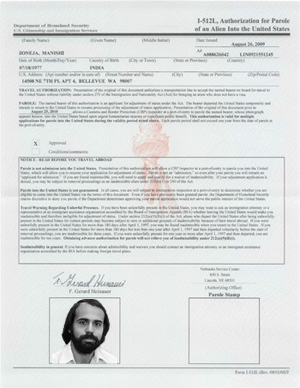
Advance Parole and Travel Documents
USCIS Form I-131 is used to make applications for three types of documents: (1) advance parole, (2) a travel document, and (3) a refugee travel document. When an alien applies to adjust status to permanent resident, generally if she departs the United States while the application is pending, USCIS will consider her to have "abandoned" the application. To avoid the application being abandoned, the applicant must apply for and receive advance parole, or advance permission to reenter the United States after travel abroad. A travel document allows a permanent resident, or asylee to travel abroad for longer periods than otherwise possible without USCIS determining that the resident or asylee "abandoned" his residence or asylee status.
Advance Parole
Advance parole is generally valid for one year and may be for a single re-entry or multiple re-entries to the United States. An applicant may apply for advance parole up to 120 days before his current, valid advance parole expires. And that 120 days is not necessarily four months. It is 120 days, meaning when intervening months have more or fewer than 30 days, it may be more or less than four months.
Advance parole approval notices are given on a form I-512L that looks much like a USCIS I-797 receipt or approval notice. The I-512L is printed on multicolored cotton bond paper and bears the Department of Homeland Security seal and a color photo of the applicant printed onto the surface of the paper.
An alien using advance parole must present the original I-512L approval notice at the port of entry. A photocopy is not acceptable. 
Not every applicant to adjust status requires advance parole. USCIS regulations note that H and L nonimmigrants are not deemed to have abanadoned a pending adjustment of status application after travel abroad. 8 CFR §245.2(a)(4)(ii)(C). See USCIS Memo of Robert L. Bach, AFM Update: Dual Intent Follow-up Guidance: H-1 and L-1; Pending Applications for Adjustment of Status. However, H and L nonimmigrants, including dependents, who require new H or L visas, or who may face unfriendly immigration officials at a port of entry, are wise to apply for advance parole as an insurance policy. If they are unable to revalidate their H or L visa at a US consulate abroad, or if there is some other problem with their admission as a nonimmigrant, the advance parole approval form will provide a valuable insurance policy to help the alien re-enter the United States.
Additionally, H-4 spouses who work using an employment authorization document are generally held to no longer be in H-4 status because H-4 status does not allow work. If an H-4 spouse in this situation seeks to return to the United States using an H-4 visa, it is possible that Customs and Border Protection will not readmit the alien in H-4 status and may instead admit the H-4 spouse using some other method that could result in the spouse's pending adjustment application being deemed abandoned.
USCIS has confirmed that H and L nonimmigrants (H-1B, H-4, L-1A, L-1B, L-2) who enter using advance parole (as a "parolees") may apply to extend H or L status. See USCIS Memo of Robert L. Bach, AFM Update: Dual Intent Follow-up Guidance: H-1 and L-1; Pending Applications for Adjustment of Status. In other words, if a foreign national has H-4 status, a pending adjustment of status application and advance parole, departs the United States and reenters using advance parole, that parolee may then apply using form I-539 to extend H-4 status and be returned to H-4 status. However, it is important to remember that H-4 status does not allow work, so if a dependent spouse or child in H-4 status applied for an employment authorization card and is working, that dependent must remain a parolee and is not eligible for H-4 status. As the USCIS memo above indicates, applying for work authorization is not the same as using it. An H-4 who applies for work authorization and receives it, but who does not work, may maintain valid H-4 status. The regulations allow those in L-2 status -- the spouses and dependent children of L-1 workers -- to work using an employment authorization card, so work does not violate L-2 status provided the L-2 dependent first obtains a valid work authorization card from USCIS.
The Travel Document
Permanent residence is not permanent. A permanent resident retains his status only so long as he "intends" to make the United States his actual residence. The law makes assumptions about the question of intent by shifting the burden of proof. A resident absent from the US for less than six months is presumed not to have abanded his residence. A resident absent longer than six months is presumed to have abandoned his residence. In other words, if the government wants to deport a resident for abandonment and the resident has been absent for less than six months, the government must prove that the resident abandoned his residence because he actually resides someplace else. A resident absent for more than six months, if the government seeks to deport him, must prove that he did not abandon his residence and all the while intended that the United States was his actual residence. The law says that absences of more than one year are "conclusively" presumed to constitute an abandonment of residence.
For a disccussion of how a permanent resident can
lose his status, please read this article.
A travel document looks like a white passport. To reenter the United States, the resident possessing the travel document must present the original at the port of entry to the United States.
A travel document generally allows a permanent resident to remain outside of the United States for up to two years without abandoning his permanent residence. A permanent resident can usually apply for and successfully obtain two back-to-back travel documents allowing for a total of four years outside of the United States without being deemed to have abandoned permanent residence.
A permanent resident who wants to travel should consider applying for a travel document well in advance of the planned travel. Travel documents often do little good if the resident departs and then applies. A resident is supposed to make the application and receive the approved travel document before departing on her trip.
Travel documents do not help with physical presence requirements when qualifying for citizenship. If a permanent resident resides outside of the United States for two years using a travel document, it is likely that it will negatively affect the physical presence requirements for a naturalization application.
visit us at:
San José, CA 95008
Santa Cruz, CA 95060
The Olender Pro Bono Project
We represent some clients who have compelling cases and little money at no charge. Sean received the Benito Juarez human rights award in 2008 and the ALRP Volunteer Award in 2012 for taking more than 10 pro bono cases in 12 months. We need volunteers. E-mail Debbie to volunteer.
Change Your Address at DHS!
If you are not a US citizen, you must change your address with DHS within 10 days of moving or face deportation. Click Here.






































